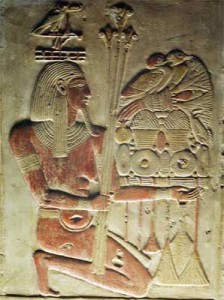Osiris is the most important Egyptian god, having a cult following that grew beyond Egypt’s borders. Modern-day Egypt still celebrates festivals dedicated to him. Osiris is usually depicted as a mummy wearing the Atef crown with a crook and flail in his hands.
Egyptian God Osiris

Osiris has usually depicted in human form wrapped up as a mummy, holding a crook and flail. He was often depicted with green skin, alluding to his role as a god of vegetation. He wore a crown known as the ‘atef’, composed of the tall conical white crown of Upper Egypt with red plumes on each side.
Osiris, is also known as the Lord of the dead among the ancient Egyptian gods, was responsible for overseeing the underworld. He was the husband of Isis and the father of Horus, and according to the myth, he was murdered by his own brother, the god Seth.
Osiris was not the only ruler of the dead but also the power that granted all life from the underworld, from sprouting vegetation to the annual flood of the Nile River. From about 2000 BCE onward it was believed that every man, not just the deceased kings, became associated with Osiris at death.
This identification with Osiris, however, did not imply resurrection, for even Osiris did not rise from the dead. Instead, it signified the renewal of life both in the next world and through one’s descendants on Earth. In this universalized form Osiris’s cult spread throughout Egypt, often joining with the cults of local fertility and underworld deities.
Celebration of Osiris
Several festivals during the year were held in Egypt, in celebration of Osiris. One, held in November, celebrated his beauty. Another, called the “Fall of the Nile” was a time of mourning.
As the Nile receded, the Egyptians went to the shore to give gifts and show their grief over his death. When the Nile began to flood again, another festival honoring Osiris was held whereby small shrines were cast into the river and the priests poured sweet water in the Nile, declaring that the god was found again.
Some versions of the history of Osiris state that when he descended into the underworld he took over several important roles and duties as the Egyptian god of the underworld from Anubis, who was believed to have been his son.
Other tales contend that he rightfully obtained the important role as the Egyptian god of the underworld because he was the first god to have died. However he obtained the role, it became Osiris’ responsibility to judge the souls of the dead. Osiris remained as one of the most popular of all the ancient Egyptian gods.